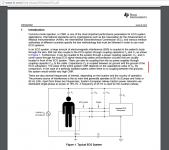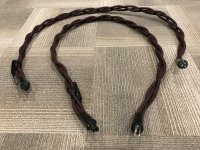But I would not recommend anything but myrtle wood blocks; Cardas is selling them for a reasonable price CARDAS - MYRTLEWOOD BLOCKS | Shop Music Direct
I see they still call it the rarest hardwood, far from the truth. At least for Oregon myrtle I found ~$7 BF wholesale. An easy DIY 4" thick slabs could allow cutting all you need from one piece, think of the seamless integrity of the sound.
But the R & D going into their final product is what costs the most, no?I see they still call it the rarest hardwood, far from the truth. At least for Oregon myrtle I found ~$7 BF wholesale. An easy DIY 4" thick slabs could allow cutting all you need from one piece, think of the seamless integrity of the sound.

Go back and look at the patent that I have the link for
I've looked at the patent, which claims the invention of a ferroelectric field coupling device.
Hello? Would one of those audiophiles stand up and be counted please?. . . as reported by audiophiles that are skilled in the art, in the context of a high-end audio systems, ferroelectric materials, when used for power line noise reduction, tend to have superior sonic characteristics.
In the interests of the 'art' of audio, please re-submit your report to this thread!
But the R & D going into their final product is what costs the most, no?
I wonder if it improves taste too.
Myrtlewood
Whether ferrites do harm to audio depends on which ferrites and how they are used. A blanket ban of ferrites would be as silly as a blanket ban on ceramic capacitors.Rick Miller said:Many people have found thru listening, that Ferromagnetic material like ferrite clamps and rings sound bad. They affect the sound in a bad way. I believe it says this in the patent. Forum member Charles Hansen (RIP) talked about how ferrite should be kept away from audio equipment.
Are you saying that any ferroelectric cannot have this problem, or that specific ferroelectrics do not have this problem?But Ferroelectric material does not have this problem, that is one of the reasons Shunyata uses it.
What about the problem that the ferrolectric filter described in the patent doesn't do anything useful below VHF frequencies. How do you remove lower frequencies from your mains supply without using ferrites?
Sorry, the temptation to correct a pedant was irresistible. My apologies.Jakob2 said:I still think "pedantry" is useful if you discuss the correctness of information; hadn´t you objected to my post about "complex wave impedance" i hadn´t noticed that a problem with my usage of the terms exist.
I am sorry but I’ve never seen such a noisy cardiograph trace with ordinary hospital installations like the one shown as “without Hydra Power Conditioner”, not even with elementary cardiographs plugged into standard wall outlets in a physician’s office.
YouTube
Oh for goodness sake, they have a ground loop.
The equipment is sensitive to grounding of the patient.
One of the patient electrodes is a ground reference, the patient is touching metal that is earthed.
John
Last edited:
What do you suggest is correct application and how to go wrong please ?.Whether ferrites do harm to audio depends on which ferrites and how they are used.
IME 'normal' usage is clipped around AC cables and whilst lowering system noise floor they can leave/cause a subjective 'glassy/hardness' character to high mids/highs, lows are screwed up too.
Dan.
So how would one go about measuring line power noise with a sound card?
Say one was shooting for 96KHz or 192KHz bandwidth.
Transformer coupling is probably right out unless one had a transformer specifically wound for the purpose. Typical power transformers like a 120VAC:2.5VAC filament transformer wouldn't have the bandwidth.
A resistor divider is simply asking for trouble from a safety standpoint.
What about capacitive coupling with film caps, then high pass filtering before the sound card input to reduce the 60Hz component?
Say one was shooting for 96KHz or 192KHz bandwidth.
Transformer coupling is probably right out unless one had a transformer specifically wound for the purpose. Typical power transformers like a 120VAC:2.5VAC filament transformer wouldn't have the bandwidth.
A resistor divider is simply asking for trouble from a safety standpoint.
What about capacitive coupling with film caps, then high pass filtering before the sound card input to reduce the 60Hz component?
Oh for goodness sake
Most probably John.
The noise components shown is around 10-15Hz. (IMD ?)
Electrocardiographs are high passed at 40Hz or 150Hz (selectable)
http://www.ti.com/lit/an/sbaa188/sbaa188.pdf
http://www.clevelandclinicmeded.com...RK 11 Klein 12 Lead ECG interpretation v2.pdf
George
Attachments
<snip>
Sorry, the temptation to correct a pedant was irresistible. My apologies.
Touché and no problem, i´m not such a shy plant and as you avoided "apparently offensive" posting style ....
On the Electrocardiograph shill video the thing I never got about that is that wiring codes for that sort of an installation are, at least in UK very tight. So unless they found a real life Dr
Nick, how did they get that stuff signed off?
Nick, how did they get that stuff signed off?
Argh! I read chopstickaudio....
... Maybe I'll have to look into doing some DIY chopsticks, to improve the perceived experience when eating sushi and listening to music at the same time? Would it be better to do a matte absorbing surface to reduce possible reflections? Could possibly help improve grip also. And the missus a.k.a. "boss lady" would probably be happy I made something not so obtrusive for once...
This actually turned into quite the useful thread after the mindless bashing ended.
My sincere thanks to everyone involved.
I have no problem with opinions at any time, I positively welcome them when that is what's asked for. It doesn't mean I have to careThis actually turned into quite the useful thread after the mindless bashing ended.
That first waveform display bracketed what looked like a full cycle of the noise, with 17ms displayed. Looks like a duck.Most probably John.
The noise components shown is around 10-15Hz. (IMD ?)
Electrocardiographs are high passed at 40Hz or 150Hz (selectable)
http://www.ti.com/lit/an/sbaa188/sbaa188.pdf
http://www.clevelandclinicmeded.com...RK 11 Klein 12 Lead ECG interpretation v2.pdf
George
Jn
Last edited:
Oh, I hadn’t noticed it.
And I made a wrong assumption about heart wave interval
Thanks John
George
And I made a wrong assumption about heart wave interval
Thanks John
George
- Status
- Not open for further replies.
- Home
- Member Areas
- The Lounge
- Aftermarket ac power cable-put your opinions here too :-)


